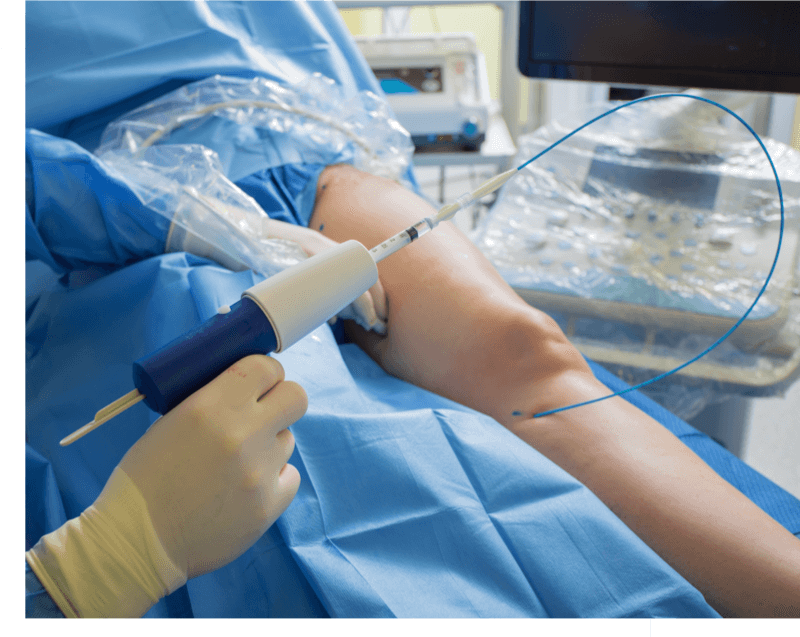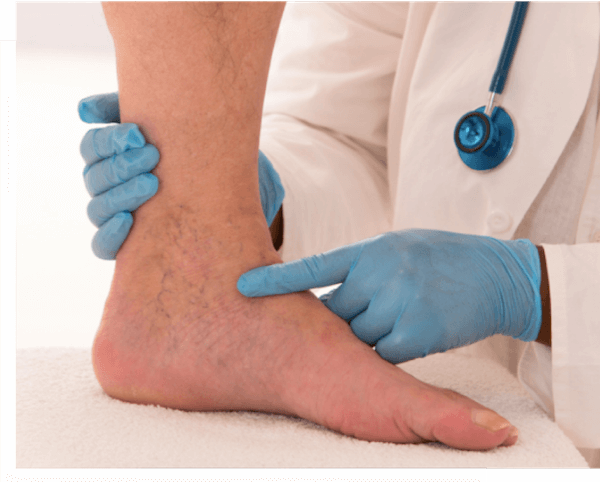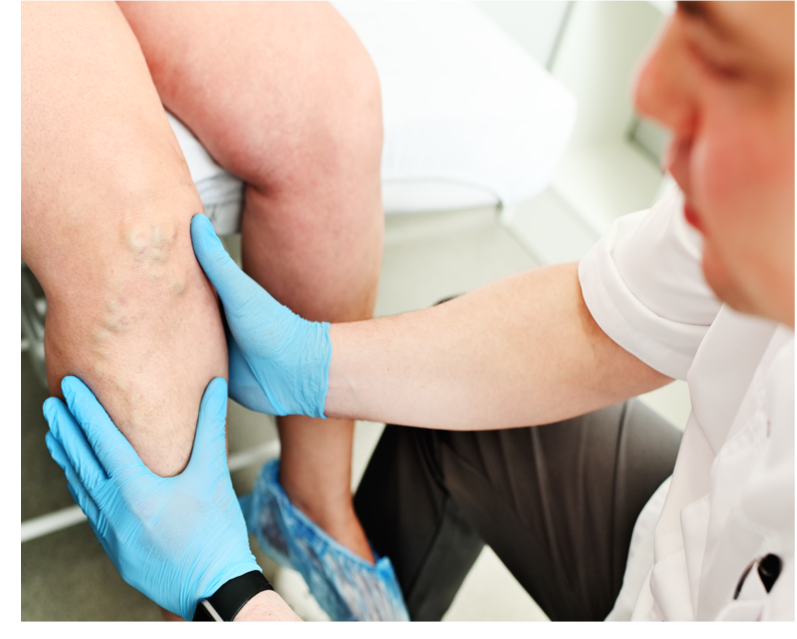VenaSeal Procedure in Los Angeles
Minimally Invasive Varicose Vein Treatment

The VenaSeal procedure is a unique method of varicose vein treatment that has distinct advantages over other treatment options, specifically when it comes to patient comfort and post-procedure recovery. In this article, the vein specialists at ProVascularMD provide a rapid review of how VenaSeal works and how its technical features might provide a better patient experience than other vein treatment options.
Quick Navigation:
What is VenaSeal?
How does VenaSeal work?
What to expect during the VenaSeal procedure?
How does VenaSeal compare to other vein treatment options?
Is VenaSeal right for me?

Vein Specialist
Dr. Michael Lalezarian
What is VenaSeal?
VenaSeal is a bio-adhesive ‘glue’ that’s designed for use in the veins. It was approved by the FDA in 2015 for the treatment of adults with clinically symptomatic venous reflux / varicose veins. [1] Like other varicose vein treatments, the goal of a VenaSeal procedure is to permanently close down diseased veins. [2]
How Does VenaSeal Work?
The VenaSeal adhesive is an n-butyl-2-cyanoacrylate (NBCA) based formulation. The chemistry behind the device is similar to other bio-adhesives used to close surgical incisions, wounds, and lacerations. Kept isolated, the VenaSeal solution is a clear, sterile, free-flowing liquid. Upon contact with bodily fluids, such as blood inside the vein, the individual molecules of NBCA begin to polymerize. Within minutes, this creates a solid material within the vein, which then becomes surrounded by fibrous tissue, creating a durable occlusion. [1]

What to Expect During the VenaSeal Procedure?
How Does VenaSeal Compare to Other Treatments?
No Heat, No Tumescence, Fewer Needlesticks
Until recently, thermal ablation devices, such as radiofrequency and laser treatment, were the ‘gold standard’ for minimally invasive varicose vein treatment. Thermal devices work by applying short bursts of focused heat to the inside of the vein that causes the vein to collapse. Many medical procedures are destructive in nature, so patients shouldn’t find this type of approach alarming. However, thermal treatment does require certain safeguards to protect patients from the adverse effects of extreme heat – one of which is the use of tumescent anesthesia. Tumescent anesthesia is a liquid that numbs the treatment area while providing a heat-conducting medium for the safe delivery of thermal energy. [3] Covering the entire length of a vein with anesthesia often requires several uncomfortable needlesticks.
In contrast, VenaSeal is entirely non-thermal and does not require tumescent anesthesia. This generally means fewer needle sticks for patients and a more comfortable procedure. Readers should note that Varithena foam sclerotherapy offers many of the same advantages as VenaSeal, which is why our vein specialists offer both treatments here at ProVascularMD.
Immediate Recovery & Return to Normal Activities
The non-thermal nature of VenaSeal can also make it easier for patients to return to work and resume moderate exercise immediately following their procedure. With thermal ablation, on the other hand, it can take patients a few days to fully recover from thermal ablation. This point is further emphasized in human studies directly comparing a VenaSeal procedure to thermal ablation, which has demonstrated that treatment with VenaSeal sees less post-procedural pain and bruising than treatment with thermal ablation. [5]
No Compression Stockings

Similar Clinical Outcomes
Is VenaSeal Right for Me?
In summary, the VenaSeal procedure is as effective as any other vein treatment option while potentially providing patients with a more comfortable experience and an easier post-procedure recovery. If you have questions about VenaSeal or any other other vein treatment options, get in touch with us at ProVascularMD. We offer individualized vein treatment at four dedicated vein centers in Los Angeles and surrounding cities.
Stages of Venous Insufficiency
Learn about the stages of venous insufficiency, from spider veins to venous leg ulcers.
Vein Screening
We break down each step in the diagnosis of vein disease so you know what to expect.
Vein Treatment in Los Angeles
Learn about your vein treatment options, including foam sclertherapy, Venaseal, and thermal ablation.
Learn how minimally invasive vein treatments can help accelerate healing.
Learn more about Los Angeles Vein Specialist Dr. Michael Lalezarian.
Schedule Your Visit
Click the Chat Button
Vascular Care in Los Angeles
& San Bernardino County
Adelanto
Alhambra
Amboy
Angelus Oaks
Apple Valley
Arcadia
Azusa
Baker
Baldwin Park
Barstow
Bell Gardens
Big Bear City
Big Bear Lake
Bloomington
Blue Jay
Bryn Mawr
Burbank
Cedar Glen
Cedarpines Park
Chino
Chino Hills
Cima
Citrus
City of Industry
Claremont
Colton
Covina
Crestline
Daggett
Diamond Bar
Downey
Duarte
Eagle Rock
Earp
El Monte
Essex
Fawnskin
Fontana
Forest Falls
Fort Irwin
Glendale
Glendora
Grand Terrace
Green Valley Lake
Guasti
Hacienda Heights
Helendale
Hesperia
Highland
Highland Park
Hinkley
Irwindale
Joshua Tree
La Canada
La Crescenta
La Habra
La Mirada
La Puente
La Verne
Lake Arrowhead
Landers
Loma Linda
Lucerne Valley
Ludlow
Lytle Creek
Mentone
Monrovia
Montclair
Montebello
Monterey Park
Morongo Valley
Mountain Pass
Mt Baldy
Needles
Newberry Springs
Nipton
Norwalk
Ontario
Oro Grande
Parker Dam
Pasadena
Phelan
Pico Rivera
Pinon Hills
Pioneertown
Pomona
Rancho Cucamonga
Redlands
Rialto
Rimforest
Rosemead
Running Springs
San Bernardino
San Dimas
San Gabriel
Santa Fe Springs
Sierra Madre
Skyforest
South El Monte
South Pasadena
Sugarloaf
Temple City
Trona
Twentynine Palms
Twin Peaks
Upland
Victorville
Vidal
Walnut
West Covina
West San Dimas
Whittier
Wrightwood
Yermo
Yucaipa
Yucca Valley





